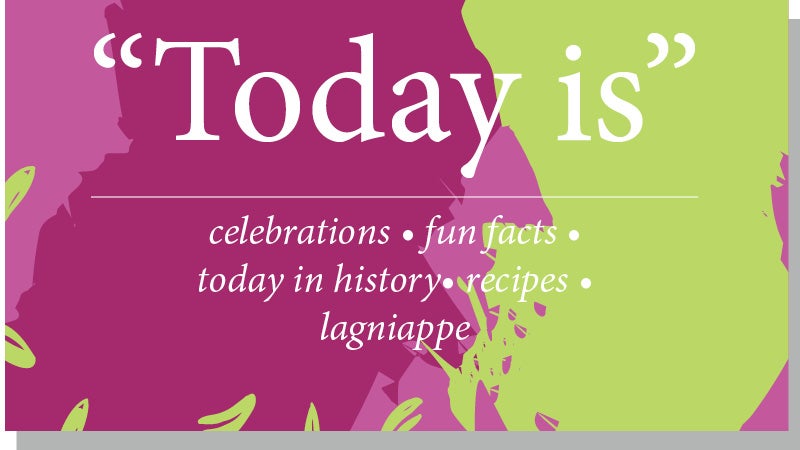Today is November 4
Published 12:52 am Thursday, November 4, 2021
|
Getting your Trinity Audio player ready...
|
Chocolate wasn’t always the sugar-sweetened dessert people consume today. The history of chocolate dates back to 1900 BC, when Aztecs believed the cacao seeds were the gift of Quetzalcoatl, the god of wisdom. Chocolate was made into fermented beverages, and the cacao beans also were used as a form of currency because they held so much value.
According to the History Channel, some ancient civilizations considered chocolate to be a mood enhancer and aphrodisiac. Chocolate was believed to have mystical properties and was revered so much that it was reserved for rulers, warriors and priests.
It was not until centuries later that edible chocolate became popular among the masses. Dutch chemist Coenraad Johannes van Houten invented the cocoa press, which could turn extrude cocoa butter, paving the way for the modern age of chocolate as a confectionary ingredient and gift.
Choosing the right type of chocolate may require gaining an understanding of various chocolate-related terms.
· Cocoa powder: This is the unsweetened raw form of cocoa made from partially defatted chocolate liquor. Dutch-processed (alkalized) cocoa powder is milder and less acidic than natural cocoa powder.
· Unsweetened chocolate: “Bitter” or “baking chocolate” are other names attributed to unsweetened chocolate. It is best used in baking when it can be combined with sugar and other ingredients. It is also the base ingredient of most forms of chocolate, with the exception of white chocolate.
· Dark chocolate: Chocolate that contains only chocolate liquor, sugar, cocoa butter, vanilla, and lecithin is considered dark chocolate. No milk solids are added in. The higher the percentage on the wrapper, the more bitter the chocolate.
· Milk chocolate: In addition to dark chocolate ingredients, milk chocolate also contains dry milk solids or condensed milk. It is sweet and has a mild chocolate taste.
· Bittersweet and semi-sweet: These chocolates are milder than dark chocolate, but not as sweet as milk chocolate. Many chocolate manufacturers derive their own formulations for these types of chocolate, varying the amount of cocoa solids they include.
· Couverture chocolate: An expensive chocolate, this is coveted by professional bakers or confectioners. It contains a high percent of cocoa butter and chocolate liquor, which helps it to melt evenly. It is ideal for tempering and can coat candies smoothly.
· Ganache: Ganache is a whipped filling, glaze, icing, or sauce that is used in various desserts. It is made by heating cream and pouring over chocolate of any kind. When cooled, it is malleable but not runny, which is why ganache is often used in making candies or fillings.
· Truffle: A chocolate truffle is made from a ball of ganache rolled in cocoa powder. Truffles can be made from any variety of chocolate.
**
Preparing for Thanksgiving: Apps
Thanksgiving is a food lover’s paradise. Even though the turkey and side dishes are the crowning achievements on Thanksgiving, hungry guests will need something to tide them over until the pièce de résistance is ready. In such situations, bite-sized appetizers that are tasty yet not too filling can fit the bill.
Charcuterie boards and tasting menus continue to be all the rage. In addition to a platter of fruit slices, figs, aged cheeses and crostini, treat guests to “Mini Cheese Ball Bites,” which offer various textures and flavors in bite-sized morsels. Enjoy this recipe, courtesy of “Spectacular Spreads: 50 Amazing Food Spreads for Any Occasion” (Rock Point) by Meagan Brown.
Mini Cheese Ball Bites
Makes 12
8 ounces light cream cheese, softened
1 cup shredded sharp cheddar cheese
3 tablespoons drained, chopped pimentos
1 teaspoon garlic powder
1 teaspoon paprika
Pinch kosher salt
Pinch freshly ground black pepper
1/2 cup crushed pecans
1/4 cup chopped chives
12 pretzel sticks
In a large bowl, stir together the cream cheese, cheddar, pimentos, garlic powder, paprika, salt, and pepper until well combined. Cover and refrigerate for at least 30 minutes.
Place the crushed pecans and chives in a small bowl. Set aside.
Roll the cheese mixture into twelve 1-inch balls. Evenly coat each ball with the pecan-chive mixture. Press a pretzel stick into the top of each cheese ball just before serving. Serve at room temperature or chilled.






